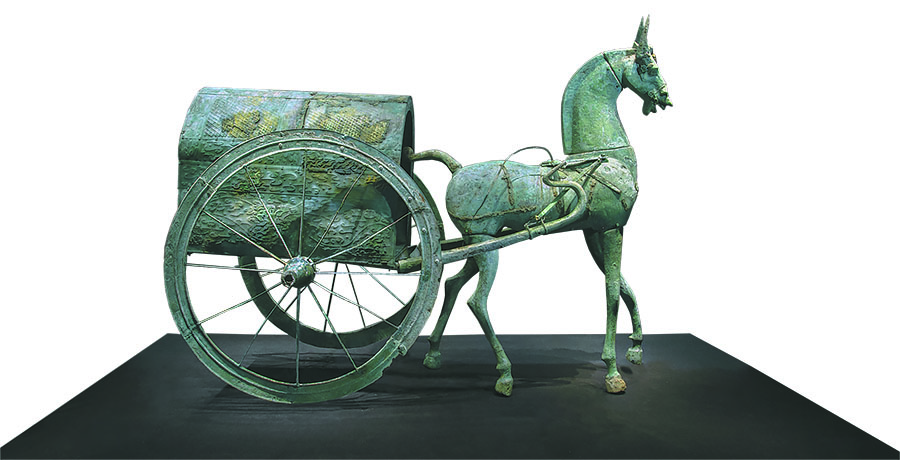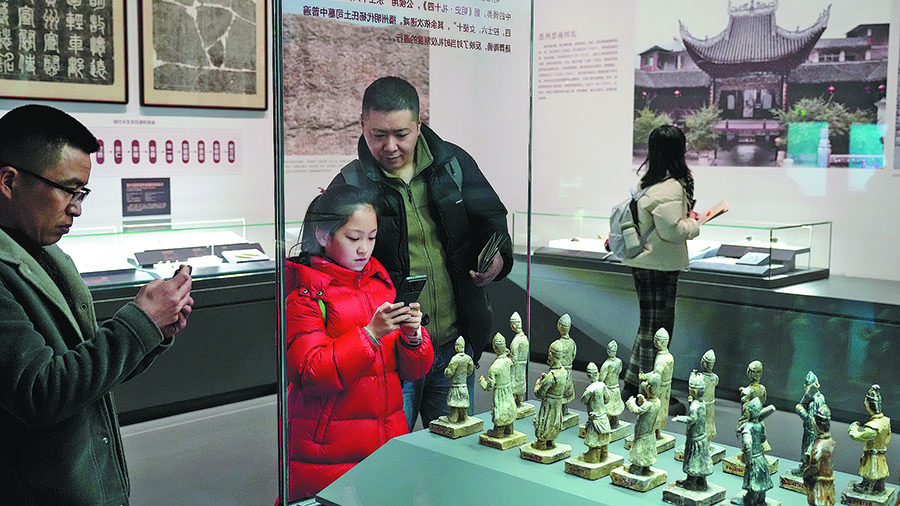Information
Bronze chariots take visitors on epic historical ride

Guizhou exhibition provides a tantalizing glimpse into an ancient culture, Yang Feiyue and Yang Jun report in Guiyang.
A tomb offering of a bronze chariot and horse from the Eastern Han Dynasty (25-220) has been the center of attention since it was unveiled in February at the Guizhou Provincial Museum in the provincial capital of Guiyang. Known as the Zi Chariot, it is 1.12 meters in length and 0.88 meters in height.
"It is made of bronze, and shows exquisite craftsmanship," says He Jiaojiao, a guide at the museum, adding that the find demonstrates the strength and organization of the ancient kingdom's armed forces.
The artifact includes a horse with the carriage, and consists of more than 200 components.
"The horse is made up of 11 sections, including head, tail, neck, legs, body and ears, and is posed tail arched with its head held high, and standing on three legs with one lifted as if ready to gallop," He says.
The carriage consists of the driver's seat, wheels and axles, and a carriage box with a canopy. "The canopy curls into a U shape, and the back of the carriage is decorated with hollowed-out floral patterns. Not only are there patterns of mats on the carriage, there are also cloud patterns," she adds.
According to the experts, the chariot and horse is significant for being one of the most complete of its kind and offers insights into the study of transportation, as well as the Han Dynasty (206 BC-AD 220) bronze casting process.
It is one of the highlights of The Exhibition of Colorful History and Cultures in Guizhou — Landscapes Carry Rich Humanities, Mountains Carry Lengthy Time, which systematically presents a comprehensive history of Guizhou's 300,000 years of heritage.
"It's a heavyweight exhibition meticulously put together over a period of three years," says Li Fei, curator of the Guizhou museum.

The exhibition covers 6,000 square meters, with a visitor route of approximately 2 kilometers. There are around 3,500 cultural relics on display, about 80 percent of which are being shown to the public for the first time, Li says.
Right next to the Zi Chariot is the Yao Chariot, which is also from the Eastern Han Dynasty and which was unearthed in Xingren city in 1987.
Also cast in bronze, it was made using a variety of techniques including inlay work and interlocking joints.
Most scholars believe that the chariot was used by ordinary officials, and was usually pulled by a single horse.
The chariots speak to the flourishing of Han Dynasty transportation in Guizhou and enable museumgoers to see the diversity in form and function of bronze carriages and horses in ancient times, Li says.

Other precious items include an Eastern Han Dynasty celadon jar, as well as batik clothes and skirts with egret patterns and a gold crown inlaid with gemstones and featuring five phoenix panels from the Ming Dynasty (1368-1644).
The fully glazed celadon jar has a small rim and bears an inscription indicating that it was made in AD 104. The jar, with its value inscribed on its surface, was used to hold sacrificial wine and is the first of its kind found in Guizhou that has an inscription.
"In addition to the introductory and concluding halls, the exhibition is divided into six parts according to the chronological order," Li says.
It presents Guizhou from the prehistoric through to the pre-Qin period (pre-221 BC), the Qin (221-206 BC) and Han eras, and then in stages all the way to the Ming and Qing (1644-1911) dynasties.
Visitors can walk down through history and experience the way Guizhou gradually integrated itself into the core of Chinese culture, Li says.
Well-known experts in the fields of history, archaeology and museum studies were invited to consult to enhance the exhibition and ensure its accuracy, Li adds.
He says that a variety of display methods including re-creations of scenes, sculpture, historical miniature landscapes, interactive multimedia, graphic panels and 3D printing are combined with physical exhibits to create a profound sense of historical immersion and help museumgoers assimilate the latest archaeological findings in Guizhou. Fan Tongshou, a senior local historian, who helped write the introductory texts for the exhibition, says the design outline was meticulously devised and vividly reflects Guizhou's historical context while highlighting its cultural essence.
The goal is to enable museumgoers to understand Guizhou and how historically its various ethnic groups lived, as well as the path it traversed in history, Fan says, adding that the exhibition is an overview of Guizhou's historical and cultural timeline, and documents the cultural heritage of the prehistoric era and 5,000 years of civilization.

Gu Jiu, former president of the provincial cultural and history research institute, says the exhibition marks "a solid step forward in Guizhou's cultural development".
He says the exhibition has achieved the goal of providing newcomers with an overview of Guizhou and gives those who return a deeper appreciation of the province.
However, he stresses that the exhibition demonstrates that there are still many stories hidden in history that require further exploration.
Meng Aijun, vice-curator of Guizhou's provincial institute of cultural and historical research, and member of the National Committee of the Chinese People's Political Consultative Conference, says the exhibition serves important educational purposes. Since the start of the 21st century, archaeological discoveries have been taking place across the country, and these findings and sites preserve the historical and cultural memories of various regions and eras, Meng says.
Interdisciplinary research institutions and expert groups, Meng suggests, should collaborate and conduct in-depth studies on the history of the formation of the Chinese nation in archaeological sites across the country, providing a systematic interpretation of the development trend of the nation.
Lu Yongzheng, head of the province's publicity department, says the exhibition vividly presents significant historical events in multiethnic interaction, exchange and integration that occurred in Guizhou.
"It successfully presents a historical and cultural scroll of Guizhou that demonstrates the formation and development of China, proving that Chinese civilization is diverse yet integrated," Lu says.
He says he hopes that all cultural and tourism institutions in the province, as well as its museum staff, will use the exhibition as an opportunity to upgrade exhibitions to better meet public cultural needs.

One museumgoer, Zhang Aimeng, was impressed by the display of the two chariots facing each other during his visit in February.
"This arrangement is special, and it's also the first time I've seen two sets of chariots and horses facing each other in the same environment," Zhang says.
"If you understand the stories behind them and trace back the memories of the era, it's as if you can also see some parts of the dynasties."
Zhao Yandi and Gan Meizhi contributed to this story.

Category: English
News
Information
Key words:
